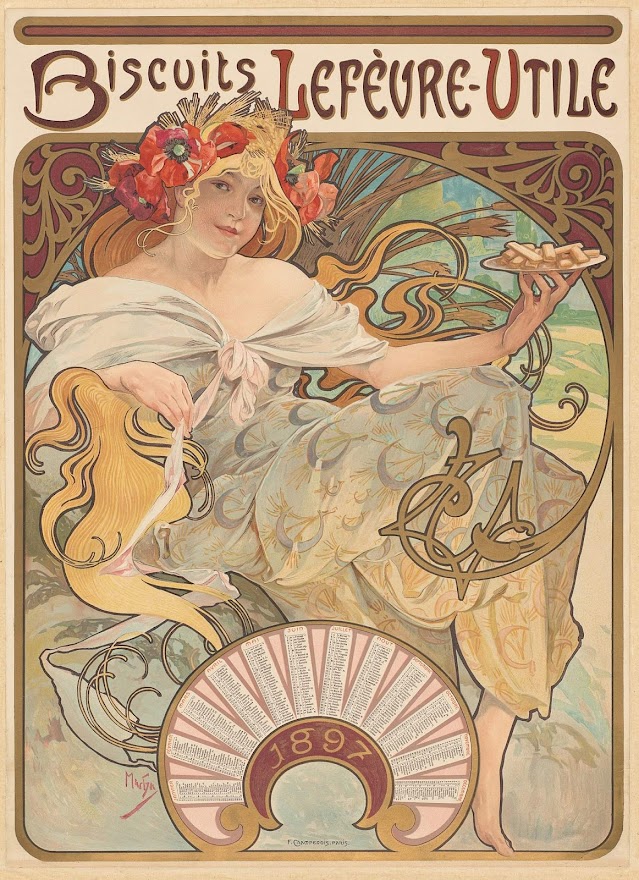Art Nouveau Cookies – Inspired by Alphonse Mucha’s “Biscuits Lefèvre-Utile”
Recipe: Art Nouveau Sugar Cookies
During the late 19th and early 20th centuries, there was a noticeable shift in the world of food and baking, particularly in Europe and the United States. The period saw a rise in the availability of ingredients, the invention of new baking techniques, and the growth of the baking industry.
During this time, cookies and baked goods became increasingly popular due to the expansion of sugar production, which made sweet treats more accessible and affordable. This period also saw the development of new leavening agents like baking soda and baking powder, which allowed for a greater variety of baked goods with different textures and flavors.
The Art Nouveau movement, influenced food presentation as well. Beautifully crafted serving dishes, utensils, and decorative elements on pastries and cakes reflected the elegance and intricate designs of the movement.
Ingredients:
Cookies
- 1 cup (2 sticks) unsalted butter, softened
- 1 cup granulated sugar
- 1 large egg
- 2 teaspoons pure vanilla extract
- 3 cups all-purpose flour
- 1/2 teaspoon baking powder
- 1/4 teaspoon salt
- Food coloring (preferably gel-based)
Royal Icing
- 4 cups powdered sugar
- 3 tablespoons meringue powder
- 1/2 cup warm water
- 1 teaspoon pure vanilla extract
- Food coloring (preferably gel-based)
Instructions
- In a large bowl, cream together the softened butter and sugar until light and fluffy.
- Add the egg and vanilla extract, and mix until combined.
- In a separate bowl, whisk together the flour, baking powder, and salt. Gradually add the dry ingredients to the wet ingredients, mixing until a dough forms.
- Divide the dough in half and shape each half into a disk. Wrap each disk in plastic wrap and refrigerate for at least 1 hour.
- Preheat the oven to 350°F (175°C). Line baking sheets with parchment paper.
- Roll out one disk of dough on a lightly floured surface to 1/4-inch thickness. Cut out cookies using desired shapes and transfer them to the prepared baking sheets.
- Bake for 10-12 minutes, or until the edges are just starting to turn golden. Remove from the oven and let cool on the baking sheets for 5 minutes before transferring to wire racks to cool completely.
- While the cookies cool, prepare the royal icing by combining the powdered sugar, meringue powder, warm water, and vanilla extract in a large bowl. Beat with an electric mixer on low speed until smooth and thick.
- Divide the icing into separate bowls, one for each desired color. Add food coloring to each bowl and mix until the desired shade is achieved.
- Decorate the cookies with the colored royal icing, using piping bags fitted with small round tips or paint brushes. Allow the icing to dry completely before storing or serving the cookies.
Alphonse Marie Mucha: Biscuits Lefèvre-Utile
"Biscuits Lefèvre-Utile" is a poster created by Alphonse Mucha in 1896 as an advertisement for the French biscuit company Lefèvre-Utile. Mucha was a renowned Czech artist known for his distinctive Art Nouveau style that often featured beautiful, ethereal women with flowing hair, surrounded by decorative patterns and intricate details.
In this particular poster, a woman is depicted with long, flowing hair adorned with flowers. She is holding a plate with an assortment of biscuits, showcasing the product being advertised. The background is ornate and features floral designs and other decorative elements, which are characteristic of Mucha's style. The harmonious composition and intricate details make this poster a striking example of Art Nouveau design and a testament to Mucha's talent as an artist.
Alphonse Marie Mucha
Alphonse Mucha (1860-1939) was a Czech artist and one of the most influential figures in the Art Nouveau movement, which flourished in Europe and the United States during the late 19th and early 20th centuries. Mucha gained widespread recognition for his distinctive style, characterized by elegant, elongated figures, flowing lines, and intricate, decorative backgrounds featuring floral motifs and ornamental details.
Mucha began his artistic career as a theatrical scene painter but later moved to Paris, where he studied at the Académie Julian. He rose to fame after creating a poster for the famous actress Sarah Bernhardt in 1894, which led to numerous commissions for posters, advertisements, and illustrations. Apart from posters, Mucha also designed jewelry, furniture, and even theatrical sets and costumes.
Today, Alphonse Mucha is celebrated as one of the leading artists of the Art Nouveau movement, and his work continues to inspire and captivate audiences worldwide.










Comments
Post a Comment